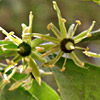Balanites aegyptiaca (Desert date) is a short summer-deciduous tree with a single distinct trunk. Its crown is dense and thorny, reminiscent of the Jujube (Ziziphus). The tree sends out additional shoots from the root, and sometimes appears in groups. The young branches are green and pilose. The leaf is carried on a short petiole, and is composed of two leaflets, which indicates its relation to the Bushy Bean-Caper (Zygophyllum dumosum) and to the other members of its family. The leaflets are small, with a length of 2 cm. They are round or somewhat elongated, pilose when young and leathery to the touch. The thorn is straight, with a length of 1-4 cm. It originates from a shortened branch. The Hebrew name is taken from the Arabic name of the tree.
Desert date blooms from February to July, and under favorable conditions even until December. The flower is bell-shaped or star-shaped, green, small (with a diameter of 7 mm). It is not prominent and has a very short pedicel. The flower has 5 deciduous sepals, 5 petals, 10 stamens. The fruit is felty, spherical to ovate, and resembles an overgrown olive. It has a diameter of 3 cm, is green at the beginning, then brown-yellowish, and when it ripens it turns blue. The fruit has an oily pulp and one stony seed. The fruit has a sweet taste with a very bitter aftertaste.
Desert date grows in the borderland region (in the transition between the Mediterranean and the desert region), in warm and somewhat humid places. It is rare. Its distribution spreads mainly in the Jordan Valley – north up to Kfar Ruppin (a planted grove of desert date is thriving near Ein Gev), and sparsely southwards up to Eilat. Mature groves of desert date are known in Wadi Qelt and near Hatzeva.
Wood remains of desert palm were found in archeological digs in layers beginning from the Neolithic period in Jericho, through the Roman period at Masada, and until the Byzantine period at Ein Gedi and Nitzana.
Desert date wood is good for construction, for engraving, for production of furniture and work tools. Its fruits are used to produce oil, which was called “the balm of Gilead”. The oil is regarded as medicine for muscle and joint pains. Eating the fruits was regarded as a remedy against abdominal worms and against constipation. The leaves were used for healing purulence.
Its global distribution spreads over the savannas of east Africa and the Thar Desert in India. The genus contains 20 species but only one grows in Israel.
Written by Mike Livne






